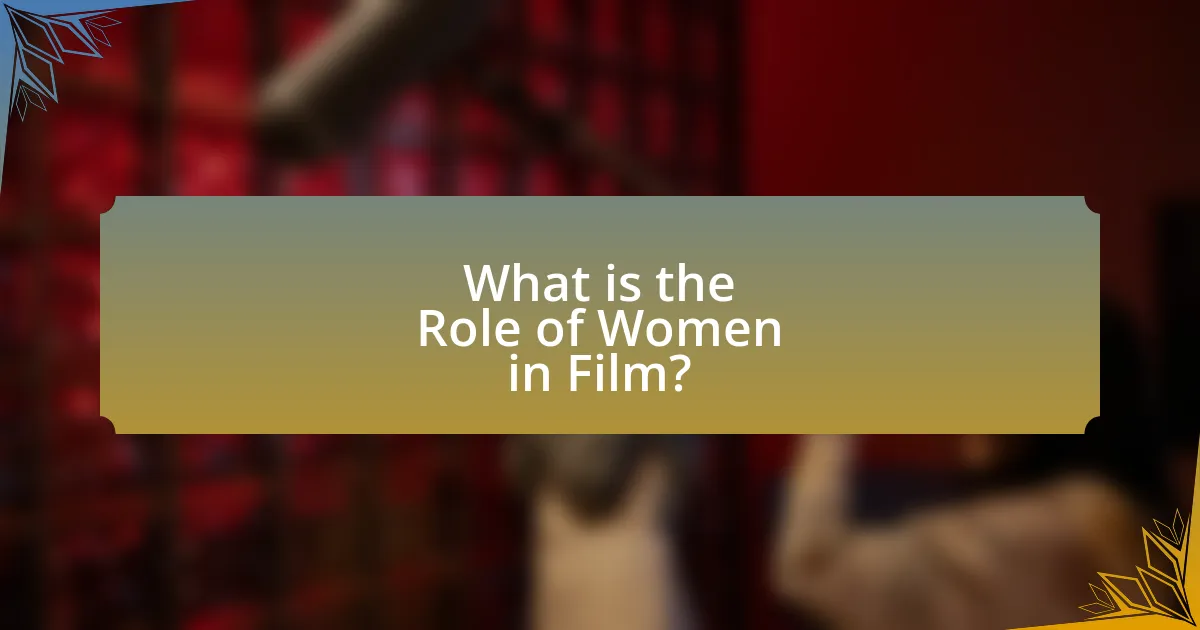The article examines the role of women in film, with a particular focus on Patty Jenkins, a prominent filmmaker known for her groundbreaking work, including the successful “Wonder Woman.” It outlines the historical evolution of women’s representation in cinema, highlighting key milestones and cultural shifts that have influenced their roles. The article also discusses the impact of female filmmakers on storytelling, the importance of gender diversity in the industry, and the challenges faced by women like Jenkins. Additionally, it explores initiatives aimed at promoting gender equality in film and offers practical steps to support aspiring female filmmakers.

What is the Role of Women in Film?
The role of women in film encompasses various positions, including directors, producers, writers, and actors, significantly influencing storytelling and representation. Women have historically faced barriers in the film industry, but their contributions have become increasingly recognized, with notable figures like Patty Jenkins, who directed “Wonder Woman,” showcasing women’s perspectives and narratives. According to a 2020 report by the Center for the Study of Women in Television and Film, women comprised 16% of directors for the top 100 grossing films, highlighting ongoing challenges but also progress in female representation behind the camera. This evolution underscores the importance of women’s roles in shaping the film industry and promoting diverse storytelling.
How has the representation of women in film evolved over time?
The representation of women in film has evolved from stereotypical roles to complex, multifaceted characters. In the early 20th century, women were often depicted as passive, supporting figures, primarily in domestic roles. By the 1970s and 1980s, the feminist movement influenced film, leading to stronger female protagonists, as seen in films like “Alien” featuring Sigourney Weaver. The 21st century has seen a significant shift, with women taking on leading roles in diverse genres, exemplified by Patty Jenkins’ “Wonder Woman,” which not only showcases a powerful female superhero but also emphasizes themes of empowerment and agency. This evolution reflects broader societal changes and a growing recognition of women’s narratives in cinema.
What key milestones have marked the progress of women in the film industry?
Key milestones that have marked the progress of women in the film industry include the establishment of the first female directors in the early 20th century, such as Alice Guy-Blaché, who directed over 1,000 films. The 1970s saw the emergence of influential female filmmakers like Lina Wertmüller, the first woman nominated for an Academy Award for Best Director in 1977. In 2017, Greta Gerwig became the fifth woman nominated for Best Director at the Oscars for “Lady Bird,” highlighting the increasing recognition of women in leadership roles. Additionally, Patty Jenkins directed “Wonder Woman” in 2017, which became the highest-grossing film directed by a woman at that time, showcasing women’s capability to lead blockbuster films. These milestones reflect the gradual but significant advancements in women’s representation and influence within the film industry.
How do cultural shifts influence women’s roles in film?
Cultural shifts significantly influence women’s roles in film by altering societal perceptions and expectations of gender representation. For instance, the feminist movements of the 1960s and 1970s led to increased visibility of female characters and narratives, as seen in films like “Thelma & Louise,” which challenged traditional gender roles. Additionally, contemporary movements such as #MeToo and Time’s Up have prompted the industry to address issues of sexism and inequality, resulting in more complex and empowered female characters, as exemplified by Patty Jenkins’ “Wonder Woman,” which portrays a strong female lead in a traditionally male-dominated genre. These shifts reflect broader societal changes, demonstrating that as cultural attitudes evolve, so too do the roles and representations of women in film.
Why is it important to analyze women’s contributions to film?
Analyzing women’s contributions to film is important because it highlights the significant impact women have had on the industry, both in front of and behind the camera. Women have historically been underrepresented in film, yet their contributions have shaped narratives, influenced genres, and driven social change. For instance, directors like Patty Jenkins have not only achieved critical and commercial success but have also paved the way for future female filmmakers, as evidenced by Jenkins’ “Wonder Woman,” which grossed over $800 million worldwide and redefined the portrayal of female superheroes. Recognizing these contributions fosters a more inclusive understanding of film history and encourages diversity in storytelling, ultimately enriching the cinematic landscape.
What impact do female filmmakers have on storytelling?
Female filmmakers significantly enrich storytelling by introducing diverse perspectives and narratives that challenge traditional norms. Their unique experiences and viewpoints often lead to the exploration of themes such as gender, identity, and social justice, which have historically been underrepresented in mainstream cinema. For instance, Patty Jenkins’ “Wonder Woman” not only broke box office records but also redefined the superhero genre by centering on a female protagonist and showcasing her journey in a way that resonates with both women and men. This shift in storytelling not only broadens audience engagement but also fosters a more inclusive film industry, as evidenced by the increasing number of films directed by women that receive critical acclaim and commercial success.
How does gender diversity affect the film industry as a whole?
Gender diversity positively affects the film industry by enhancing creativity, broadening storytelling perspectives, and improving financial performance. Studies show that films with diverse female representation tend to perform better at the box office; for instance, a 2019 report by McKinsey & Company found that companies with more women in decision-making roles are 21% more likely to outperform their counterparts in profitability. Furthermore, gender diversity leads to richer narratives that resonate with wider audiences, as evidenced by the success of films directed by women, such as “Wonder Woman,” which grossed over $800 million globally. This trend indicates that gender diversity not only fosters innovation but also drives economic success in the film industry.

Who is Patty Jenkins and what is her significance in film?
Patty Jenkins is an American filmmaker known for directing critically acclaimed films, most notably “Wonder Woman” (2017), which became a significant milestone in the superhero genre. Her significance in film lies in her role as one of the first female directors to achieve substantial box office success, grossing over $800 million worldwide, thereby paving the way for more female representation in a predominantly male industry. Jenkins’ work has not only challenged gender stereotypes but has also inspired a new generation of female filmmakers, highlighting the importance of diverse voices in storytelling.
What are Patty Jenkins’ most notable works?
Patty Jenkins’ most notable works include the films “Monster” (2003) and “Wonder Woman” (2017). “Monster” earned Jenkins an Academy Award nomination for Best Actress for Charlize Theron’s portrayal of Aileen Wuornos, showcasing Jenkins’ ability to direct powerful performances. “Wonder Woman” became a cultural phenomenon, grossing over $821 million worldwide and establishing Jenkins as the first woman to direct a major superhero film, significantly impacting the representation of women in the genre.
How did “Wonder Woman” change the landscape for female-led superhero films?
“Wonder Woman” significantly changed the landscape for female-led superhero films by proving that a female protagonist could lead a blockbuster franchise successfully. Released in 2017, the film grossed over $821 million worldwide, making it the highest-grossing live-action film directed by a woman at that time. This success demonstrated the commercial viability of female-led narratives in a genre traditionally dominated by male characters. Additionally, “Wonder Woman” received critical acclaim, with a 93% approval rating on Rotten Tomatoes, which further validated the demand for more female-centric superhero stories. The film’s impact has led to an increase in female-led superhero projects in development, reshaping industry perceptions and paving the way for future films featuring women in leading roles.
What themes does Jenkins explore in her films?
Patty Jenkins explores themes of empowerment, identity, and resilience in her films. In “Wonder Woman,” she emphasizes female strength and independence, showcasing a protagonist who defies traditional gender roles. Jenkins also delves into the complexities of personal and societal identity, as seen in “Monster,” where she portrays the struggles of a woman facing societal rejection. These themes are reinforced by Jenkins’ focus on strong female characters who navigate challenges, ultimately highlighting the importance of women’s narratives in cinema.
What challenges has Patty Jenkins faced in her career?
Patty Jenkins has faced significant challenges in her career, including gender bias in a male-dominated industry and the struggle to secure funding for her projects. Despite her success with “Wonder Woman,” Jenkins encountered skepticism regarding her ability to lead large-scale productions, which is a common hurdle for female directors. Additionally, she dealt with the pressure of high expectations following her groundbreaking work, which can create a challenging environment for continued success. These obstacles highlight the broader issues women face in the film industry, where representation and recognition remain ongoing challenges.
How has Jenkins navigated the male-dominated film industry?
Patty Jenkins has navigated the male-dominated film industry by consistently breaking barriers and achieving significant milestones as a female director. She gained widespread recognition with “Wonder Woman,” which became the highest-grossing live-action film directed by a woman at the time, earning over $800 million globally. Jenkins has also advocated for female representation in filmmaking, emphasizing the importance of diverse voices in storytelling. Her success has inspired other women in the industry, demonstrating that female directors can lead blockbuster films and achieve critical acclaim.
What barriers has she overcome to achieve success?
Patty Jenkins has overcome significant barriers such as gender bias in a male-dominated industry and the challenge of securing funding for her projects. As a female director, she faced skepticism regarding her capabilities, particularly after the initial struggles of her early career. Jenkins broke through these obstacles by directing “Wonder Woman,” which became a critical and commercial success, grossing over $800 million worldwide and proving that female-led films can thrive. This achievement not only validated her talent but also opened doors for more women in directing roles, demonstrating the impact of her success on the industry.
What lessons can be learned from Patty Jenkins’ career?
Patty Jenkins’ career teaches the importance of perseverance and vision in filmmaking. Jenkins faced significant challenges, including a long gap between her acclaimed debut film “Monster” and her blockbuster “Wonder Woman,” which demonstrated her resilience in a male-dominated industry. Her success emphasizes the value of strong storytelling and character development, as seen in her ability to create a compelling female superhero narrative that resonated with audiences, leading to “Wonder Woman” grossing over $800 million worldwide. Additionally, Jenkins’ work highlights the necessity of representation in film, showcasing that diverse voices can lead to groundbreaking and commercially successful projects.
How can aspiring female filmmakers follow in Jenkins’ footsteps?
Aspiring female filmmakers can follow in Patty Jenkins’ footsteps by focusing on storytelling that resonates with diverse audiences and advocating for female representation in film. Jenkins has successfully created compelling narratives, such as “Wonder Woman,” which emphasizes strong female characters and themes of empowerment. By pursuing unique and authentic stories, aspiring filmmakers can carve out their own niche in the industry. Additionally, they should seek mentorship and networking opportunities within the film community, as Jenkins has often highlighted the importance of support from other women in the industry. Engaging in film festivals and workshops can also provide valuable exposure and experience, further aligning with Jenkins’ path to success.
What strategies did Jenkins use to establish her voice in the industry?
Patty Jenkins established her voice in the industry through a combination of unique storytelling, strong character development, and a focus on female perspectives. By directing “Monster,” Jenkins showcased her ability to tell complex, emotionally charged stories, which earned her critical acclaim and recognition. Additionally, her work on “Wonder Woman” highlighted her commitment to portraying strong female characters in a traditionally male-dominated genre, further solidifying her influence. Jenkins’ strategic choice to focus on narratives that resonate with diverse audiences has positioned her as a leading voice in contemporary cinema.
How can mentorship play a role in supporting women in film?
Mentorship can significantly support women in film by providing guidance, networking opportunities, and industry insights that are often less accessible to them. For instance, established filmmakers like Patty Jenkins serve as mentors, helping emerging female talent navigate the complexities of the film industry, which has historically been male-dominated. Research indicates that mentorship can lead to increased career advancement and job satisfaction; a study by the American Psychological Association found that mentees are more likely to receive promotions and higher salaries. This evidence underscores the importance of mentorship in fostering a more inclusive environment for women in film.
What are the future prospects for women in film inspired by Jenkins’ work?
The future prospects for women in film inspired by Jenkins’ work are increasingly promising, as her success has paved the way for more female-led projects and diverse storytelling. Jenkins’ groundbreaking direction of “Wonder Woman,” which grossed over $800 million worldwide, demonstrated the commercial viability of female protagonists and directors, encouraging studios to invest in similar projects. This shift is reflected in the growing number of films directed by women, which rose to 16% in 2021, up from 7% in 2015, according to the Center for the Study of Women in Television and Film. Jenkins’ influence has also inspired initiatives aimed at supporting women filmmakers, such as the establishment of mentorship programs and funding opportunities, further enhancing the landscape for women in the industry.
How can the industry continue to evolve to support female filmmakers?
The industry can continue to evolve to support female filmmakers by increasing funding and resources specifically allocated for projects led by women. Research from the Geena Davis Institute on Gender in Media indicates that films directed by women receive significantly less funding compared to their male counterparts, which limits opportunities for female filmmakers. Additionally, implementing mentorship programs that connect emerging female directors with established industry professionals can foster growth and provide essential guidance. Statistics show that mentorship can increase the likelihood of success for women in film, as evidenced by initiatives like the Sundance Institute’s Women at Sundance program, which has successfully supported numerous female filmmakers.
What initiatives are in place to promote gender equality in film?
Initiatives to promote gender equality in film include the 50/50 by 2020 campaign, which aims for equal representation of women in film by the year 2020, and the Time’s Up movement, which addresses systemic inequality and harassment in the industry. Additionally, organizations like Women in Film provide resources, mentorship, and funding to support female filmmakers. The Geena Davis Institute on Gender in Media conducts research to highlight gender disparities in film and advocates for change. These initiatives collectively work towards increasing women’s visibility and opportunities in the film industry.
What practical steps can be taken to support women in the film industry?
To support women in the film industry, organizations and stakeholders can implement mentorship programs that connect emerging female filmmakers with established industry professionals. Research indicates that mentorship significantly enhances career advancement opportunities; for instance, a study by the Geena Davis Institute on Gender in Media found that women with mentors are more likely to secure leadership roles in film. Additionally, promoting equitable hiring practices through diversity quotas can ensure that women are represented in key production roles. The 2021 Hollywood Diversity Report highlighted that films with diverse teams perform better at the box office, demonstrating the economic benefits of inclusivity. Furthermore, providing funding specifically for female-led projects can help address the gender funding gap, as only 16% of directors of the top 100 grossing films from 2007 to 2019 were women, according to the Center for the Study of Women in Television and Film. These practical steps can create a more supportive environment for women in the film industry.


